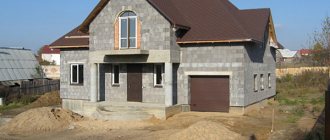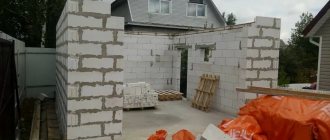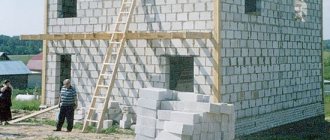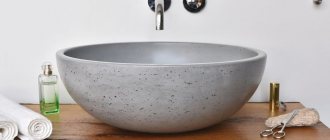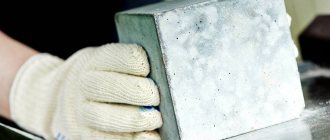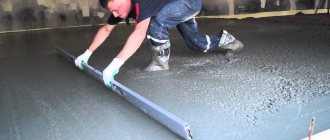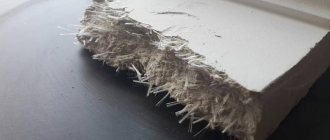Penetrating waterproofing has been known for a long time. Back in Soviet times, special compositions based on sodium methyl siliconate were used, which were used to impregnate the surfaces of concrete, stone and brickwork. As a result of a chemical reaction of the substance with carbon dioxide, an insoluble polymer gel was formed, which filled the pores of the material from the inside. The water resistance, strength and frost resistance of concrete or brickwork increased several times, and, accordingly, the service life of the material also increased. After all, it is the influence of moisture and adverse weather conditions that is the reason for the rapid destruction of any building made of concrete or brick. Previously, such waterproofing was practically not used in everyday life, for example, to protect the floor in the bathroom from possible leaks, as is done now.
Recently, penetrating waterproofing for the protection of foundations, swimming pools, bathrooms, basements and other structures that may be constantly exposed to the harmful effects of moisture has been gaining increasing popularity in the professional environment. And there are very good reasons for this. Let's look at all the advantages of such waterproofing.
What are the advantages of penetrating waterproofing over rolled and mastic materials?
Scheme of the operating principle of penetrating waterproofing
The foundation is the most important element, the basis of any structure. And if it is not reliably protected from the effects of adverse factors, the service life of the building will be significantly reduced. The effect of groundwater on an unprotected concrete foundation can result in this period being reduced to several years. After which the house will gradually begin to collapse: humidity will reign in the rooms, cracks will begin to appear on the walls, and mold will grow in the dark corners. The proximity to woodlice and mold colonies can hardly be called pleasant, but these are still “flowers”. The impact of groundwater on the foundation can lead to the collapse of the building - this is really serious.
To avoid a sad scenario, at the stage of constructing the foundation, care should be taken to ensure its reliable waterproofing. The use of special roll coatings and bitumen mastics does not completely solve the problem.
Disadvantages of mastics and roll materials in comparison with penetrating waterproofing:
- Rolled and mastic materials protect the structure only from the application side;
- Any defect or damage to the protective layer can lead to moisture penetration into the concrete surface;
- The presence of seams in rolled insulation is its most vulnerable point, therefore the material has to be laid in two layers to cover the surfaces of the seams, and this significantly increases the consumption and cost of work;
- If the groundwater level is high enough, the service life of rolled insulation may be reduced to three to five years;
- The main disadvantage of mastic waterproofing is also its fragility;
- If the work is carried out after the construction of the house, then coating and roll type insulation requires mandatory digging out of the outer wall.
Penetrating foundation waterproofing easily solves all these issues. Why? Its action is based on a completely unique principle. The composition of dry building mixtures for waterproofing may vary, but usually it is a cement mixture with the addition of quartz sand and chemicals that have the ability to penetrate deeply into the cellular structure of concrete. Where, during a chemical reaction, crystals are formed that densely fill the pores of the material from the inside. These crystals become part of the concrete structure, compacting it and preventing water from penetrating.
Applying penetrating insulation using a roller
The main advantages of penetrating waterproofing:
- At the construction stage, penetrating waterproofing of the foundation is ensured by adding a dry mixture such as Penetron Admix (or other brands) to the composition of the concrete being mixed. This changes the structure of concrete, turning it into a qualitatively different material. The foundation will be protected from the effects of groundwater throughout the entire thickness of the structure, regardless of its depth;
- Such waterproofing lasts as long as the concrete “lives”, because the material itself becomes waterproof;
- The crystals formed inside the cells have the ability to “self-heal”: if water does penetrate into the materials during operation, the formation of crystals resumes, and the concrete “heals” itself;
- The time frame for construction or repair work is reduced, because... When using penetrating waterproofing, there is no need to thoroughly dry the concrete. The mixture must be applied to a wet surface, and the higher its humidity, the faster the chemical reactions involving the active components occur;
- Concrete retains all technical characteristics: setting speed, air permeability, mobility, frost resistance, and so on. It “breathes” and remains vapor permeable. Materials treated with penetrating waterproofing mixtures significantly change only their waterproof characteristics;
- If waterproofing work is carried out after the completion of the construction phase, then this type of insulation will allow all the necessary manipulations to be carried out without digging up the foundation of the house. The structure can be processed from any side, including from the inside;
- Penetrating waterproofing is effective in any direction of water movement and level of pressure;
Penetrating waterproofing of the entire surface of the masonry, all seams and joints prevents acidic and alkaline aggressive environments, microorganisms and fungi from penetrating into the thickness of concrete; protects materials from exposure to salty sea water, groundwater and wastewater with varying levels of harmful components.
Disadvantages of penetrating waterproofing
Application of insulation by spraying
Alas, we have not yet come up with an ideal protection for concrete structures from the effects of water, which destroys the material from the inside. Despite all its wonderful characteristics, penetrating waterproofing also has disadvantages. Let's talk about them in more detail:
- Penetrating materials cannot be used as the only shield against moisture. Protection must be comprehensive. Additional treatment of seams and joints with special mixtures is necessary to prevent moisture from seeping through these vulnerable areas;
- The cost of penetrating waterproofing is relatively expensive; the current price now varies between 2-5 dollars per 1 square meter, depending on the brand of the mixture;
- Waterproofing both inside and outside the building requires difficult preparatory work, for example, concrete walls must be absolutely clean, well-moistened, smooth, treated with acidic solutions. Waterproofing painted or plastered walls requires careful removal of old paint and plaster fragments. As well as degreasing, cleaning with sand or high pressure water, treatment with iron brushes. There must be full access to the capillary system of concrete, otherwise waterproofing will be ineffective;
- The walls must be free from cracks and damage, therefore such waterproofing is not used on old leached structures; small gaps and cracks are carefully sealed with cement mortar;
- The concrete surface is thoroughly cleaned of mold, oil stains, soil and even dust;
- Penetrating waterproofing is ineffective for walls made of aerated concrete and foam concrete, because the size of the cells in the structure of the materials is too large, and the crystals will not be able to tightly close them from the inside;
- Penetrating mixtures are not effective on masonry surfaces because the brick lacks the element necessary for the chemical reaction. Only the surfaces of the seams can be treated with waterproofing mixtures, because masonry mortar contains cement hydration products. The problem of waterproofing masonry is usually solved with the help of external protection, where roll and coating materials are used;
- The solution for treating the floor wall must be used within half an hour, therefore it is prepared in small portions - water cannot be added to the finished mixture;
- Treated walls and floor surfaces must be well protected from drying out and exposure to low temperatures. The rooms must be warm, and the walls and floor surface are either covered with film or thoroughly moistened over the next two weeks.
Important! Penetrating waterproofing of brickwork is carried out only by qualified workers using special equipment.
As they say, there is no perfection in the world. But still, penetrating waterproofing is the most reliable and effective means of protecting any concrete structures for industrial and domestic purposes: swimming pools, bathroom floors, foundations, basements, hydraulic structures, mines, tanks, piers, etc. And it remains so for many years.
Reviews about surface treatment features
Penetrating waterproofing for Lakhta concrete should be applied using spray equipment or a stiff brush. Users state that in dry climates a light wetting is necessary before the second coat is applied. If we are talking about horizontal surfaces, then the liquid solution should be applied in one layer; you can use a brush for this.
Consumers like that when working with plastic wet concrete, they can apply Lakhta by spraying the composition through a fine sieve. Then the surface to be treated is rubbed, and the coating is subject to wet drying. The surface must be left in this condition for 3 days.
Application area
Penetrating waterproofing can be used indoors.
Penetrating mixtures are used wherever protection of concrete structures from moisture is required: sewage and groundwater, sea water, etc. This protection has proven itself in various areas of construction. The chemicals that make up dry mixtures are safe for human health, which is why they are widely used for waterproofing wells, drinking water tanks, swimming pools, and bathrooms.
The mixtures are effective when used even from inside buildings. For example, penetrating basement waterproofing is effective for protecting against groundwater, even without additional application to the foundation walls. This reduces the cost and duration of repair work, because the foundation does not need to be dug up and thoroughly dried, as is done in the case of using roll and mastic waterproofing systems.
The non-toxicity of the mixtures allows them to be used in residential areas: in the bathroom to protect walls and floors from the harmful effects of moisture, in residential areas of the basement, and so on.
Types of waterproofing for formwork
Important! Any finishing work should be postponed while the crystallization process takes place. Any type of plaster, including gypsum, or other decorative finishing materials can be applied to a surface treated with waterproofing compounds no earlier than after 30 days.
If you do not wait the required time before starting finishing work, the finishing will be hopelessly damaged.
Pros and cons of penetrating coatings
[ads1]For a wooden house, I use penetrating compounds to protect the basement, foundation, and roof. But the scope of use of the composition is almost limitless; it can be used to treat walls, floor joists, and rafter systems. You can work with the material inside the house and outside. Positive reviews about waterproofing are associated with its main advantages:
- Waterproofing with a layer of 10 cm in 1 pass.
- Healing of microcracks in concrete structures.
- The frost resistance of concrete structures increases 2-3 times.
- Resistance to chemical influences.
- The service life of the impregnating concrete protection is more than 25 years.
- The structure remains vapor-permeable, which means the circulation of oxygen in the wooden house is not disrupted.
- Can be applied from the inside and outside of the building at any temperature.
Over time, the effect of waterproofing only becomes stronger. And it can be applied to any surface, dry or wet. Negative reviews are mainly about the high price of the material.
Popular building mixtures for penetrating waterproofing
Penetron
Penetron building mixtures are widely used for industrial and domestic purposes.
Penetrating waterproofing Penetron is a patented building mixture that has been used in construction around the world for more than 50 years. This is a special cement mixture containing quartz sand and active chemical components. Its market price is slightly higher than the average of competitors: the cost of 1 kg of dry mixture today is 4-5 dollars. And the consumption of dry mixture for treating concrete walls, floors, and building foundations is approximately 1 kg per square meter. In general, Penetron is not a cheap pleasure, although reviews say that it is worth the money. Of course, if you actually purchase a high-quality patented mixture, and not a cheap fake, which is often found on the Russian market.
The brand's building mixtures are widely used for industrial and domestic purposes. In everyday life, excellent results are achieved by protecting swimming pools, basements, foundations and bathrooms.
You can learn more about Penetron by watching the video. The video clip describes in sufficient detail the principle of operation of penetrating waterproofing. Also from the video you can learn about the rules for applying the waterproofing mixture, the preparatory process before starting work, and all subsequent stages.
Important! It is better to purchase building mixtures of the Penetron family from reliable sellers, because it is this brand that most often becomes the object of counterfeiting.
Crystallisol
The principle of operation of all waterproofing mixtures is the same: the active substances penetrate the intracellular structure of concrete, where a chemical reaction occurs with the calcium salts contained in it. Next, crystals grow, which tightly close the pores of the material, ensuring its waterproofness. Crystallisol works on the same principle, and its composition also includes river or quartz sand, special cement and patented chemicals that the manufacturer prefers to keep secret. The Kristallizol mixture is applied in the same way to a moistened concrete surface.
Use Crystallizol mixtures to protect any concrete structures exposed to permanent or temporary harmful effects of moisture
Of course, all mixtures for penetrating insulation are certainly compared with Penetron, which is understandable - for quite a long time it simply did not have worthy analogues. However, reviews from professionals indicate that Crystallizol, which, by the way, is produced in Russia, is practically not inferior to the famous brand. And in some ways it even excels. For example, Penetron has no analogues of the plaster waterproofing mixture, which is used for the repair and restoration of destroyed concrete structures, and which the Russian Kristallizol can boast of. And, of course, a reasonable price. Mixtures of the Kristallizol group are produced in Russia, therefore their market value is lower than that of Penetron. The cost of 1 kg of Crystallizol dry mixture today is approximately 1 dollar.
Crystallizol mixtures are used to protect any concrete structures exposed to permanent or temporary harmful effects of moisture. Good results are obtained by protecting swimming pools, bathrooms, any water tanks, foundations, walls and floors in basements located below the groundwater level.
You can learn more about Kristallizol waterproofing materials from the video. In a fairly long video, they talk in detail and in an accessible way about the advantages of penetrating waterproofing of this brand.
Lakhta
Another popular and high-quality Russian brand is Lakhta. They have a fairly wide range of dry construction compounds that perform a variety of tasks. The operating principle of the Lakhta penetrating waterproofing composition is the same as that of Kristallizol or Penetron: active substances enter the concrete structure, a chemical reaction occurs, and the pores of the material are tightly closed by the crystals. The liquid mixture is also applied to a pre-moistened and carefully prepared surface.
The principle of operation of Lakhta waterproofing
The price offered by Lakhta is slightly lower than that of its foreign counterpart, but higher than that of the Russian Crystallisol. On average, today the cost of Lakhta waterproofing mixture is approximately 2-3 dollars per 1 kg. Reviews from ordinary consumers and construction professionals indicate that Lakhta’s properties are practically in no way inferior to its famous competitor.
Waterproofing the foundation inside the house
Lakhta waterproofing mixtures are used to protect residential buildings and industrial facilities. Good results are obtained by using dry mixtures for waterproofing swimming pools, wells, bathroom floors and walls, balconies, basements and foundations.
You can learn how to properly prepare a waterproofing solution using the Lakhta mixture from this video. The video will also tell you how to properly prepare the concrete surface, in what proportions the dry construction mixture and water should be combined, what consistency the liquid mixture should be, and other important nuances.
Element
Another popular brand is Element. Dry building mixtures are produced by Element in the Russian city of Stavropol. The Element brand product line includes: water repellent, elastic waterproofing, penetrating waterproofing and liquid rubber to protect the roof from water. The element is distinguished by a fairly affordable price: on average, the cost of 1 kg of dry construction mixture Element on the Russian market is 1.5 dollars.
The penetrating waterproofing of this brand can be used for domestic and industrial purposes to protect concrete structures from the outside and inside. It is used for waterproofing balconies, basements, swimming pools, floors and walls in the bathroom. And also for the protection of tunnels, mines, reservoirs, hydraulic structures. And wherever it is necessary to preserve concrete structures under the constant harmful effects of groundwater and wastewater, sea water, and precipitation.
You can learn more about Element waterproofing from the video.
CT Tron
Well, the last brand we’ll talk about is KT Tron. The Kt tron product line is produced in Russia, and it is quite wide. The Kt tron “family” of building mixtures includes:
- Penetrating waterproofing mixtures;
- Compositions for protecting seams and joints of concrete structures;
- Additives that are added at the concrete mixing stage to increase its water resistance, strength, and frost resistance;
- Waterproof plasters that level the surface of the walls;
- Compositions for instantly eliminating severe pressure leaks.
The KT Tron group of building mixtures solves any problems with the construction and operation of concrete structures.
Thus, the KT Tron group of building mixtures is able to solve any problems related to the construction and operation of concrete structures. The average cost of 1 kg of dry mixture Kt Tron-1, which is used for penetrating waterproofing, is approximately $3.5. The scope of application of KT Tron building mixtures is very extensive: waterproofing of swimming pools, basements, wells, building foundations, bathrooms, walls and floors in residential premises, as well as various objects of industrial and energy complexes. Reviews from professionals about the KT Tron line of building mixtures indicate that this is a completely worthy brand. Using KT Tron products, it is possible to obtain concrete with high water resistance, corrosion resistance and strength.
You can learn more about KT Tron waterproofing materials from the video. In this video they talk about the entire product line of the brand in a very interesting way.

